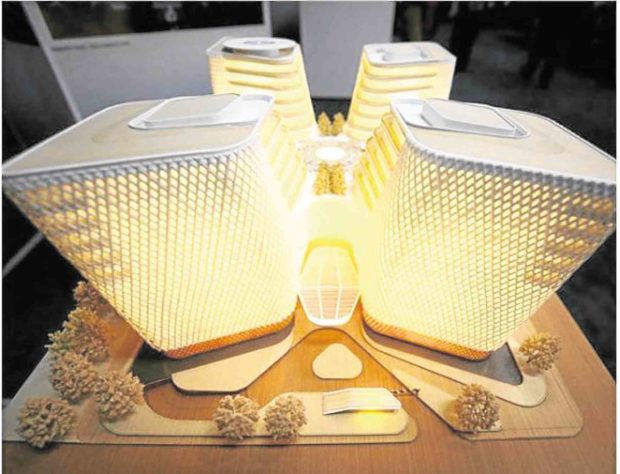Pillars of democracy

The winning design for the new Philippine Senate building by AECOM incorporates the barong Tagalog on its facade. -Photo grabbed from the Instagram account of Sen. Gatchalian.
In a few years’ time, the Senate of the Philippines will likely have a new home, one that will be at par with the different iconic parliament buildings around the world.
That’s because earlier this week, the Senate announced that the Los Angeles-based AECOM was named winner of the Global Conceptual Design Competition for the New Home of the Philippine Senate. The Senate is reportedly looking at a timeline of two years for the construction of the new building. Construction is expected to begin anytime from January 2019 to December 2020.
The idea to find a new home for the Senate of the Philippines has been around since 2000 during the Senate presidency of Sen. Aquilino Pimentel Jr.
But nothing materialized until February 2017 when Sen. Sherwin Gatchalian filed Philippine Senate Resolution No. 293 that creates an ad hoc committee to study the feasibility of relocating the Senate.
It can be recalled that the Senate, which celebrated its centennial anniversary in 2016, has been renting the use of its building from the Government Service Insurance System (GSIS) and its parking lot from the Social Security System (SSS) in Pasay City since 1996.
Article continues after this advertisementIn the sponsorship speech of Sen. Panfilo Lacson last November 2017 when the Senate committee on accounts adopted the resolution to relocate the Senate, he said that from May 1, 1996 to December 31, 2017, rental fees paid to GSIS and SSS reached P2.24 billion, an amount that would probably be enough to build a permanent, resilient and iconic Senate building.
Article continues after this advertisementAfter much deliberation and survey, an 18,320-sqm parcel of land owned by the Bases Conversion and Development Authority (BCDA) was chosen in January 2018 as the site of the new building of the Senate. The said lot is located in Navy Village in Fort Santiago, Taguig City.
On the contract to sell signed on May 23 by Senate President Vicente Sotto III and BCDA president and CEO Vivencio Dizon, the Senate was able to purchase the land for P90,000 per square meter. Lacson mentioned that the cost of the property offered by the BCDA amounted to P1.8 billion and payable in 10, or possibly more, years.
The Philippine Senate wanted to construct a building that would be at par with the different iconic parliament buildings around the world like the United States Capitol Building in Washington D.C., Palace of Westminster in London and Hungarian Parliament Building in Budapest.
To achieve this, they launched the Global Conceptual Design Competition in February to receive conceptual designs for the proposed building. Forty architectural firms, 24 foreign and 16 local, participated in the competition. Five firms were selected: AECOM, Aidea Inc., Henning Larsen Architects, Leeser Architecture, and Pelli Clarke Pelli Architects.
The five firms were judged by technical experts (40 percent), people’s choice (5 percent), and executive vote (55 percent). AECOM’s four-tower design was declared the winning design, besting the second firm with a mere 0.36 point difference.
According to AECOM, its design concept reflects the Philippine culture and incorporates sustainable features that reduce energy and water consumption.
It also features four towers made to represent the four pillars of democracy: justice, equality, freedom and representation. Each tower will house offices of the Philippine Senate while the important session hall is planned to be circular and can be found in the middle of the four buildings, a design that maximizes the function interrelationship of all towers.
AECOM, according to Lacson, will have the opportunity to undertake the detailed architectural design of the project upon the successful selection of the design and build contractor by the Department of Public Works and Highways.
AECOM is listed on the Fortune 500 as one of America’s largest companies. Among the architectural and design projects of the AECOM worldwide include the 2016 Rio Olympic and Paralympic Park in Brazil, the Samsung Cancer Center in South Korea and the Etihad Towers in Abu Dhabi.
In the Philippines, AECOM provided engineering, procurement and construction for the $1.2-billion San Roque Multipurpose Dam in Pangasinan. AECOM Philippines is a full service team of more than 200 professionals housed in the new, state-of-the-art offices in Bonifacio Global City.
Sources: www.newsenatebuilding.com, Sponsorship Speech of Sen. Lacson, PS Resolution No. 748, AECOM website, Inquirer Archives